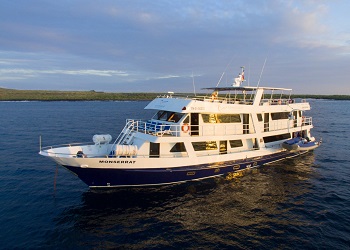CORAL I&II Itinerary C - 4 Days
ITINERARY C - 4 DAYS
SUNDAY
AM: Baltra: Arrival and Transfer to the boat
PM: North Seymour Island (HK/SN)
MONDAY
AM: Santa Cruz: Charles Darwin Research Station (HK)
PM: Mosquera Islet (HK/SN)
TUESDAY
AM: South Plaza (HK)
PM: Santa Fe (HK/KY/SN/PR)
WEDNESDAY
AM: San Cristobal: Kicker Rock / Lobos Island (HK)
San Cristobal: Transfer to the Airport
HK: HIKE / SN: SNORKEL / PR: PANGA RIDE / KY: KAYAK /
PB: PADDLE BOARD
DAY 1: SUNDAY
AM: BALTRA ARRIVAL AND TRANSFER TO THE BOAT
Departure from either Quito or Guayaquil to Baltra Island is a 2 ½ hour flight. Upon arrival in the Galapagos, passengers are greeted at the airport by our knowledgeable guides who will accompany them on a short ten-minute bus ride to the pier where they will board the Coral I or Coral II.
PM: NORTH SEYMOUR
This flat, uplifting, island is an important spot to see both magnificent and great frigatebird males courting the females and, we will also likely see courting blue-footed boobies too. Sea lions, swallow-tailed gulls, crashing surf and distant views of the Daphne Islands top off a great visit.
DAY 2: MONDAY
AM: SANTA CRUZ: CHARLES DARWIN STATAION
Once home to the famous Lonesome George, the last tortoise of the Pinta race. The center is set in the Galapagos National Park Service where various interpretative buildings are available to visit. The grounds, with large stands of native vegetation are one of the better places to spot some of the seldom seen Darwinís finches.
PM: MOSQUERA ISLET
This tiny, low-lying islet, converted into coral sand, is set between the north and south Seymour Islands. It's home to a group of sea lions that come to laze on the soft white sand, it's an excellent spot to observe shorebirds, herons, lava gulls, and boobies. Snorkeling or diving here, one can often see sharks, rays, and barracudas.
DAY 3: TUESDAY
AM: SOUTH PLAZAS
Sea lions, swallow-tailed gulls, and land iguanas are all present at the landing site. The small island is covered with a carpet of a red succulent studded with Opuntia cacti. At the cliff edge, we spend time watching birds like frigatebirds, flocks of Galapagos shearwaters, and of particular note, flights of displaying red-billed tropicbirds.
PM: SANTA FE
After a fabulous snorkel in the turquoise waters of the protected bay, we may have enjoyed time with sea lions, turtles, reef sharks and spotted eagle rays. Landing on a sandy beach, we spend time watching the abundant sea lions there with us and . We begin a walk past a forest of island-endemic giant Opuntia cacti and we can watch the Santa Fe land Iguana.
DAY 4: WEDNESDAY
AM: SAN CRISTOBAL: KICKER ROCK / LOBOS ISLAND
SAN CRISTOBAL TRANSFER TO THE AIRPORT
Isla Lobos is approximately 20 minutes by boat from Puerto Baquerizo Moreno. Once on the island, the trail is about 850 meters and there will be rocky trails and a nice & easy sand trail too. There is a small population of blue-footed boobies and great frigatebirds nests at this site.
Isla Lobos is approximately 20 minutes by boat from Puerto Baquerizo Moreno. Once on the island, the trail is about 850 meters and there will be rocky trails and a nice & easy sand trail too. There is a small population of blue-footed boobies and great frigatebirds nests at this site.
After the visit, passengers will be transferred to the airport for their return flight to Guayaquil or Quito







